| Clarkia | |
|---|---|
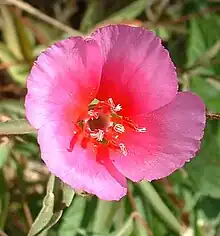 | |
| Clarkia amoena (Farewell to Spring) | |
| Scientific classification | |
| Kingdom: | Plantae |
| Clade: | Tracheophytes |
| Clade: | Angiosperms |
| Clade: | Eudicots |
| Clade: | Rosids |
| Order: | Myrtales |
| Family: | Onagraceae |
| Subfamily: | Onagroideae |
| Tribe: | Onagreae |
| Genus: | Clarkia Pursh |
| Type species | |
| Clarkia pulchella | |
| Species | |
|
over 40, see text | |
Clarkia is a genus within the flowering plant family Onagraceae. Over 40 species are currently classified in Clarkia; almost all are native to western North America, though one species (Clarkia tenella) is native to South America.
Clarkias are typically annual herbs, growing either prostrate or erect to a height of less than 2 metres. Their leaves are small and simple, from 1 to 10 cm in length depending on the species. Their flowers have four sepals and four petals, usually white, pink, or red, and are often spotted or streaked. Their fruit are elongated, cylindrical pods, usually 4-grooved or 8-grooved, and when mature they hold many tiny, cubical seeds.[1]
Several members of the genus are sometimes referred to by the common name "godetia", including Clarkia amoena, Clarkia affinis, and Clarkia lassenensis (the Lassen godetia). This is because they were formerly classified in a genus called Godetia, which is no longer recognised since its members have been absorbed into the genus Clarkia. Older sources may still use Godetia as a genus name.
The genus was named in honour of the explorer Captain William Clark. Unofficially, the genus is sometimes referred to as Yorkia, in honor of York, an African-American member of the Lewis and Clark Expedition.[2]
The Royal Navy had a warship called HMS Clarkia, a Flower-class corvette.
Cultivation
Some species are popular garden plants, for example the mountain garland, Clarkia unguiculata, the redspot clarkia, Clarkia speciosa, Farewell to Spring, Clarkia amoena and Clarkia bottae. There are cultivated varieties of some of these species.
Ecology
Clarkia species play important roles in their local ecosystems, as they provide habitat for native pollinators. Some pollinators even rely on Clarkia exclusively, such as the "Clarkia bee".[3] They are also used as host plants by some species as caterpillars, such as Sphingidae moths.[4]
Species
As of August 2023, Plants of the World Online accepted the following species:[5]
| Image | Scientific name | Distribution |
|---|---|---|
| Clarkia affinis F.H.Lewis & M.E.Lewis | California | |
 | Clarkia amoena (Lehm.) A.Nelson & J.F.Macbr. | British Columbia south to the San Francisco Bay Area. |
 | Clarkia arcuata (Kellogg) A.Nelson & J.F.Macbr. | California |
| Clarkia australis E.Small | California | |
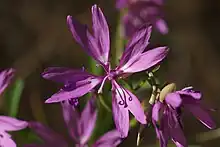 | Clarkia biloba (Durand) A.Nelson & J.F.Macbr. | Sierra Nevada foothills |
| Clarkia borealis E.Small | southern Klamath Range and the southernmost Cascade Range foothills. | |
 | Clarkia bottae (Spach) F.H.Lewis & M.E.Lewis | southern California |
 | Clarkia breweri (A.Gray) Greene | California |
 | Clarkia concinna (Fisch. & C.A.Mey.) Greene | California |
 | Clarkia cylindrica (Jeps.) F.H.Lewis & M.E.Lewis | southern California Coast Ranges, western Transverse Ranges, and southern Sierra Nevada foothills. |
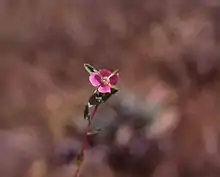 | Clarkia davyi (Jeps.) F.H.Lewis & M.E.Lewis | California |
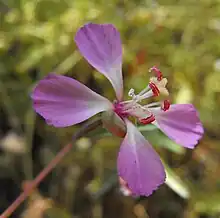 | Clarkia delicata (Abrams) A.Nelson & J.F.Macbr. | northern Baja California and adjacent San Diego County, California |
 | Clarkia dudleyana (Abrams) J.F.Macbr. | Transverse Ranges and the southern Sierra Nevada foothills. |
 | Clarkia epilobioides (Nutt.) A.Nelson & J.F.Macbr. | California, Arizona, and Baja California |
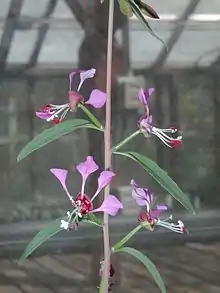 | Clarkia exilis F.H.Lewis & Vasek | western North America. |
.jpg.webp) | Clarkia franciscana F.H.Lewis & P.H.Raven | San Francisco Bay Area |
 | Clarkia gracilis (Piper) A.Nelson & J.F.Macbr. | California, Oregon, and Washington |
.jpg.webp) | Clarkia heterandra (Torr.) F.H.Lewis & P.H.Raven | California |
 | Clarkia imbricata F.H.Lewis & M.E.Lewis | Sonoma County, California |
.jpg.webp) | Clarkia jolonensis Parn. | Monterey County, California |
| Clarkia lassenensis (Eastw.) F.H.Lewis & M.E.Lewis | California, Oregon, and Nevada | |
| Clarkia lewisii P.H.Raven & D.R.Parn. | mountains of Monterey and San Benito Counties | |
| Clarkia lingulata F.H.Lewis & M.E.Lewis | Mariposa County, California | |
 | Clarkia mildrediae (A.Heller) F.H.Lewis & M.E.Lewis | southernmost Cascade Range and northern Sierra Nevada. |
 | Clarkia modesta Jeps. | North and Central Coast Ranges and the Sierra Nevada foothills. |
 | Clarkia mosquinii E.Small | northern Sierra Nevada foothills at the border between Butte and Plumas Counties. |
| Clarkia prostrata F.H.Lewis & M.E.Lewis | San Luis Obispo County, California | |
 | Clarkia pulchella Pursh | Pacific Northwest mainly east of the Cascade Range in Washington, Oregon, Idaho, the southern margin of British Columbia |
 | Clarkia purpurea (Curtis) A.Nelson & J.F.Macbr. | Baja California; California; Arizona; Oregon; Washington; and British Columbia. |
 | Clarkia rhomboidea Douglas | western North America |
| Clarkia rostrata W.S.Davis | the California oak woodlands of the Sierra Nevada foothills around the Merced River in Mariposa County. | |
_(7778062648).jpg.webp) | Clarkia rubicunda (Lindl.) F.H.Lewis & M.E.Lewis | Central Coast California |
| Clarkia similis F.H.Lewis & W.R.Ernst | California | |
 | Clarkia speciosa F.H.Lewis & M.E.Lewis | California Central Coast and mountains and from the Sierra Nevada foothills. |
 | Clarkia springvillensis Vasek | Tulare County, California |
| Clarkia stellata Mosquin | Lake Almanor | |
| Clarkia tembloriensis Vasek | San Joaquin Valley, and into the adjacent Inner South California Coast Ranges | |
| Clarkia tenella (Cav.) F.H.Lewis & M.E.Lewis | Chile and Argentina | |
 | Clarkia unguiculata Lindl. | California |
| Clarkia virgata Greene | Sierra Nevada. | |
.jpg.webp) | Clarkia williamsonii (Durand & Hilg.) F.H.Lewis & M.E.Lewis | northern and central Sierra Nevada foothills. |
 | Clarkia xantiana A.Gray | southern Sierra Nevada and its foothills and the adjacent Transverse Ranges. |
References
- ↑ "Onagraceae - Genus Page/ Botany, National Museum of Natural History, Smithsonian Institution". naturalhistory2.si.edu. Retrieved 2020-11-24.
- ↑ Beatrice Kilat. "Five Tips for Decolonizing Language: What's in a name?". Retrieved 2023-03-10.
- ↑ Peach, Kristen; Mazer, Susan J. (2019). "Heteranthery in Clarkia: pollen performance of dimorphic anthers contradicts expectations". American Journal of Botany. 106 (4): 598–603. doi:10.1002/ajb2.1262. ISSN 1537-2197. PMID 30901494.
- ↑ Miller, Timothy J.; Raguso, Robert A.; Kay, Kathleen M. (2014-01-01). "Novel adaptation to hawkmoth pollinators in Clarkia reduces efficiency, not attraction of diurnal visitors". Annals of Botany. 113 (2): 317–329. doi:10.1093/aob/mct237. ISSN 0305-7364. PMC 3890391.
- ↑ "Clarkia Pursh". Plants of the World Online. 2017-08-19. Retrieved 2023-08-20.
External links
 Data related to Clarkia at Wikispecies
Data related to Clarkia at Wikispecies Media related to Category: Clarkia at Wikimedia Commons
Media related to Category: Clarkia at Wikimedia Commons- Jepson Manual treatment of the genus